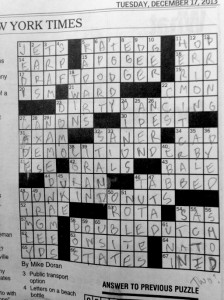Some Musings on Crossword Puzzles…
 When I was growing up, my Grandma Busch used to spend time each morning doing crossword puzzles. Off and on through my life, probably in imitation of her, I’ve enjoyed sitting down and doing them as well. The Oakland Tribune (the paper I see most often) carries two different puzzles per day: the Daily Commuter, and also the New York Times Crossword puzzle (an older one, not the current one in the NYT). I find the Daily Commuter to be pretty easy: I’m not good enough that I can just write out the answers mostly in order, I usually alternate horizontal and vertical, and in ten or twelve minutes, I usually power through them.
When I was growing up, my Grandma Busch used to spend time each morning doing crossword puzzles. Off and on through my life, probably in imitation of her, I’ve enjoyed sitting down and doing them as well. The Oakland Tribune (the paper I see most often) carries two different puzzles per day: the Daily Commuter, and also the New York Times Crossword puzzle (an older one, not the current one in the NYT). I find the Daily Commuter to be pretty easy: I’m not good enough that I can just write out the answers mostly in order, I usually alternate horizontal and vertical, and in ten or twelve minutes, I usually power through them.
The NYT is a different story though. Early in the week, they are pretty simple. The Monday puzzles are just as easy as the Daily Commuters. But as the week goes on, my time to complete these puzzles goes up. By the time Thursday or Friday rolls around, I don’t often finish them without some judicious web searching. I find those puzzles often rely on what seems to me fairly obscure references to music, literature or geography. It actually makes them somewhat less fun for me. I seldom do the Sunday Crosswords for this reason: there is just something rather crude and unaesthetic to these puzzles.
Ultimately, there is a kind of beauty in the very best crosswords. The clues are hard, but not too hard. The themes are clever. The word choices are good. I like it when there are a few words that I’ve never seen before. I find it especially interesting when these are short words. Last week I encountered the word ORT (a morsel left after a meal) which I had never seen before. Today, I encountered the word TUTEE, which seems to me a rather odd word, but also one I’d never seen before. And of course you occasionally get to use words that seem cool, but aren’t commonly used. Today, one of the answers was a great word: PALAVER. It just doesn’t get used often enough.
The thing that wasn’t obvious to me (and may not be obvious to the casual puzzler) is that there are definitely “good” and “bad” puzzles. Bad puzzles just seem like they were assembled by machine, with no more pattern than the average Sudoku (I’m not very good at Sudoku, so maybe I’m just not educated enough to see beauty in them). But I never thought that there was actual criticism of crosswords on the net…
Enter Rex Harper does the NY Times Crossword Puzzle. Each day, he bats out (probably faster than I find a pencil) the NYT crossword, blogs the answers, and then, somewhat interestingly, presents his critique of the quality of the puzzle. For instance, today’s Tribune republished the NYT from November 12, 2013, which Rex blogged about here.. I must admit, I didn’t think the puzzle was that amazing, I got through it in about 22 minutes, with a question about the intersection of the clue for 55 Down (When the balcony scene occurs in “Romeo and Juliet”) and 67 Across (Lacking depth… or like 17- 23- 37- 48- and 58-Across). My recollection was that the balcony scene had to occur in Act II, but the spacing left only a single space. Was it really in Act I? I found that hard to believe. And the across clue, what was that about? I had discovered that all the clues had a pair of “Ds” to introduce them, which was the last letter of the four letter answer. INID? That didn’t seem right. I scratched my head. I finally mused upon the answer that it really was Act 2, but written “ACT2” making the cross clue “IN2D”. I didn’t like that, without a greater theme that suggests numbers are legitimate in the puzzle, this seemed arbitrary. Annoying. Rex apparently thought so too. He says…
Nobody says “In 2D” except, perhaps, ironically. “I’m gonna go see ‘My Dinner With Andre’ in glorious 2D!” So the revealer is contrived and awkward. Also, a bra-size revealer is going to be soooo much better here. You’d have to ditch DOUBLE DUTCH, but surely there are other DD answers out there for you to use. Friend of mine suggested DDS would work as a revealer as well (interesting twist on the dental degree, which is a common crossword answer). Not a big fan of this revealer, as I’ve now made overly clear.
I suspect that when I get better at these, I’ll be an even greater critic.
Addendum: The NYT Crossword App for the iPhone/iPad is great, especially on the iPad (harder to type on the iPhone, at least for my meaty fists).
I recall burning three or four weeks of a sabbatical getting Saccade.com on the air with Wordpress. So much tweaking…